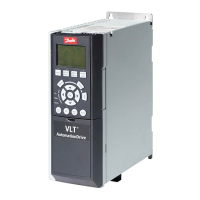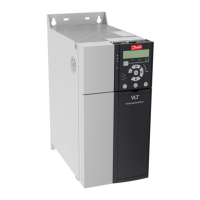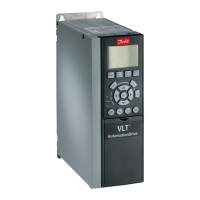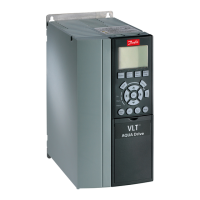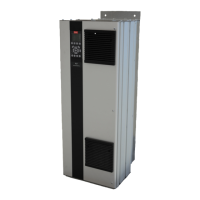NB!
The brake resistor disconnection function is tested during power-up. However the
brake IGBT test is performed when there is no braking. A warning or trip discon-
nects the brake function.
The testing sequence is as follows:
1. The DC link ripple amplitude is measured for 300 ms without braking.
2. The DC link ripple amplitude is measured for 300 ms with the brake turned on.
3. If the DC link ripple amplitude while braking is lower than the DC link ripple amplitude
before braking + 1 %:
Brake check has failed by returning a warning or alarm.
4. If the DC link ripple amplitude while braking is higher than the DC link ripple amplitude
before braking + 1 %:
Brake check is OK.
[0] * Off Monitors brake resistor and brake IGBT for a short-circuit during operation. If a short-circuit occurs,
warning 25 appears.
[1] Warning Monitors brake resistor and brake IGBT for a short-circuit, and runs a test for brake resistor dis-
connection during power-up.
[2] Trip Monitors for a short-circuit or disconnection of the brake resistor, or a short-circuit of the brake
IGBT. If a fault occurs, the frequency converter cuts out while displaying an alarm (trip locked).
[3] Stop and trip Monitors for a short-circuit or disconnection of the brake resistor, or a short-circuit of the brake
IGBT. If a fault occurs, the frequency converter ramps down to coast and then trips. A trip lock
alarm is displayed (e.g. warning 25, 27 or 28).
[4] AC brake Monitors for a short-circuit or disconnection of the brake resistor, or a short-circuit of the brake
IGBT. If a fault occurs, the frequency converter performs a controlled ramp-down. This option is
available for FC 302 only.
[5] Trip Lock
NB!
Remove a warning arising in connection with
Off
[0] or
Warning
[1] by cycling the mains supply. The fault must be corrected first. For
Off
[0] or
Warning
[1], the frequency converter keeps running even if a fault is located.
This parameter is only active in frequency converters with an integral dynamic brake.
4.3.1 2-2* Mechanical Brake
Parameters for controlling operation of an electro-magnetic (mechanical) brake, typically required in hoisting applications.
To control a mechanical brake, a relay output (relay 01 or relay 02) or a programmed digital output (terminal 27 or 29) is required. Normally this output
must be closed during periods when the frequency converter is unable to ‘hold’ the motor, e.g. due to an excessive load. Select
Mechanical Brake
Control
[32] for applications with an electro-magnetic brake in par. 5-40
Function Relay
, par. 5-30
Terminal 27 Digital Output
, or par. 5-31
Terminal 29
Digital Output
. When selecting
Mechanical brake control
[32], the mechanical brake is closed from start up until the output current is above the level
selected in par. 2-20
Release Brake Current
. During stop, the mechanical brake activates when the speed falls below the level specified in par. 2-21
Activate
Brake Speed [RPM]
. If the frequency converter enters an alarm condition or an over-current or over-voltage situation, the mechanical brake immediately
cuts in. This is also the case during safe stop.
NB!
Protection mode and trip delay features (par. 14-25
Trip Delay at Torque Limit
and par. 14-26
Trip Delay at Inverter Fault
) may delay
the activation of the mechanical brake in an alarm condition. These features must be disabled in hoisting applications.
VLT
®
AutomationDrive FC 300 Operating
Instructions
4 How to Programme
MG.33.AG.02 - VLT
®
is a registered Danfoss trademark
53
4
